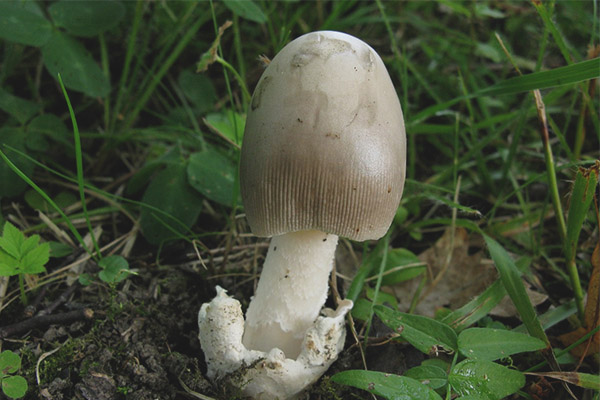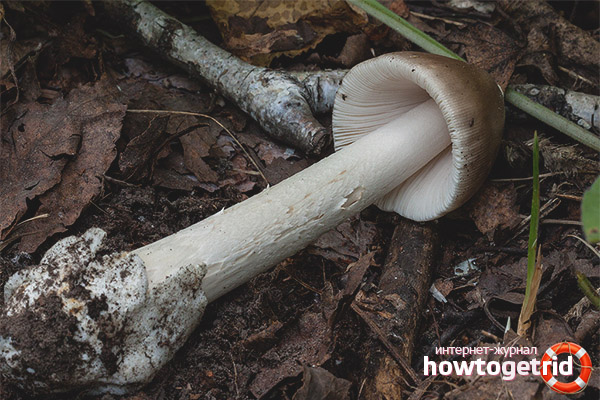The content of the article
Gray floats are more common than their relatives. They grow mostly singly, but groups of up to 10 can be found. As can be understood from the name, this member of the family is colored gray or so by a shade. Its top is not too large in diameter, sometimes it grows up to 10 cm. According to the format, the bell is a bell-shaped with some knoll in the central part. Along the edges there are notches. We will study other features in order.
Description
- As befits all representatives of the Amanita, this specimen is formed from a kind of white cocoon. Otherwise, it is called covered in a veil. First, the shape of the cocoon is ovoid, after which it cracks into several blades. A copy appears and begins full growth.
- The top is in bell format, the leg is thin. The hat grows and bulges, then smoothes over the life cycle of a particular instance. In the central part of the apex, a mound may remain, colored darker than the edges.
- The float stands out among itself-exactly the side portions of the cap. Edges with scars, as if ribbed. This is noticeable even in young animals, but is more clearly seen in mature specimens. Bedspread remains at the starting point of the leg. It hangs freely, does not interfere, is painted with a light gray or whitish shade.
- At the top can be seen flakes whitish tone. They soon disappear, because they practically do not stick. Often a white blanket sinks into the ground, so you can not see it. The base itself is covered with whitish scales, it can be smoothed.
- If the presence of rings on the base is typical for all fly-agaric mushrooms, these circles are absent in the float. It is this sign that highlights floats from fly-agaric, and you should also pay attention to cut edges.
- The tip is not too thick, it is fragile and breaks quickly. The color is colored gray, blotches of brown, greenish, brown-gray tone can be observed. But the most common specimens with a gray top. In rare cases, you can find albinos painted in pure white.
- If you turn the hat and pay attention to the plates, then it is easy to notice their decent width and whitish tone. The plates on the leg do not prostrate, do not grow.In young animals, these parts are covered with the remains of a blanket. The older the fungus, the darker its inside of the apex.
- As for taste, they are not. Also, there is no special smell that helps to distinguish this representative from among themselves. The main thing is to pay attention to the edges of the hat, as well as shade. Yellow pigment in the color should not be.
Application
- The fruit bodies discussed are edible mushrooms. Such instances without any problems can be subjected to frying. Only previously they need to boil for a few minutes. Separately, it is worth mentioning that fruit bodies have relatively low taste qualities.
- To be honest, these mushrooms are simply tasteless. In addition, they are as fragile as all the other floats. Therefore, when collecting mushrooms to deliver them home in integrity is extremely difficult. It is worth knowing that such mushrooms are saturated with a unique substance in the form of betaine.
- Just such an enzyme is successfully used in the medical industry in the treatment of cookies. In addition, with the help of betaine, you can treat a rather extensive list of various pathologies that are associated with impaired metabolism.These fruits are the only ones in their form that belong to medicinal mushrooms.
- As for traditional medicine, such fruit bodies do not apply. A close relative of the gray floats is the fly agaric. The latter is quite often found in the forests of our homeland. However, the gray float does not apply to inedible and poisonous counterparts.
Similar species
- Among the similar species is the white float. The mushroom is painted exclusively in white color from the legs to the cap. It is quite rare. At the same time, the yield of the fruit is extremely low.
- There is also a lead gray float. It is very similar to the fruit in question. The cap of this mushroom has a lead color with a bluish tinge.
- There is also saffron float. A distinctive feature of this mushroom from the gray float is a hat with a red tint. It may also be olive green.
Today we looked at a representative of the mushroom family, which in its external data can be similar to a mushroom. Therefore, it is extremely important to be able to distinguish between a float and a sebaceous one, when preparing for a quiet hunt. Pay attention to the color of the hat, as well as its edges.
Video: gray float (Amanita vaginata)












To send